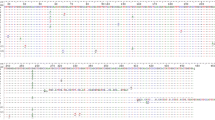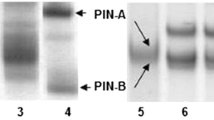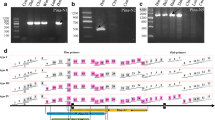Abstract
Kernel texture of wheat is a primary determinant of its technological properties. Soft kernel texture phenotype results when the Puroindoline a and Puroindoline b genes are present and encode the wild-type puroindolines PINA and PINB, respectively, and various mutations in either or both gene(s) result in hard phenotypes. A wealth of information is now available that furthers our understanding regarding the spatial and temporal regulation of expression of Puroindoline genes. Through the use of model membranes and synthetic peptides we also have a clearer understanding of the significance of the cysteine backbone, the tryptophan-rich domain (TRD) and the helicoid tertiary structures of PIN proteins in relation to their membrane-active properties. Many studies suggest individual yet co-operative modes of action of the PIN proteins in determining kernel texture, and significant evidence is accumulating that the proteins have in vivo and in vitro antimicrobial activities, shedding light on the biological roles of this unique ensemble of proteins. The puroindolines are now being explored for grain kernel texture modifications as well as antimicrobial activities.
Similar content being viewed by others
Abbreviations
- DAF:
-
Days after flowering (≈days post-anthesis)
- GSP:
-
Grain softness protein
- NILs:
-
Near-isogenic lines
- ns-LTPs:
-
Non-specific lipid-transfer proteins
- QTL:
-
Quantitative trait locus/loci
- SNP:
-
Single nucleotide polymorphism
- TRD:
-
Tryptophan-rich domain
References
Amiour N, Merlino M, Leroy P et al (2003) Chromosome mapping and identification of amphiphilic proteins of hexaploid wheat kernels. Theor Appl Genet 108:62–72
Amoroso MG, Longobardo L, Capparelli R (2004) Real time PCR and flow cytometry to investigate wheat kernel hardness: role of puroindoline genes and proteins. Biotechnol Lett 26:1731–1737
Baker RJ, Sutherland KA (1991) Inheritance of kernel hardness in five spring wheat crosses. Can J Plant Sci 71:179–181
Beecher B, Bettge A, Smidansky E et al (2002) Expression of wild-type pinB sequence in transgenic wheat complements a hard phenotype. Theor Appl Genet 105:870–877
Bhave M, Morris CF (2007) Molecular genetics of puroindolines and related genes: allelic diversity in wheat and other grasses. Plant Mol Biol (in press)
Biswas S, Marion D (2006) Interaction between puroindolines and the major polar lipids of wheat seed endosperm at the air–water interface. Colloids Surf B 53:167–174
Blein J, Coutos-Thevenot P, Marion D et al (2002) From elicitins to lipid-transfer proteins: a new insight I cell signaling involved in plant defence mechanisms. Trends Plant Sci 7:293–296
Bonafede M, Kong L, Tranquilli G et al (2007) Reduction of a Triticum monococcum chromosome segment carrying the softness genes Pina and Pinb translocated to bread wheat. Crop Sci 47:819–826
Bottley A, Xia GM, Koebner RMD (2006) Homeologous gene silencing in hexapolid wheat. Plant J 47:897–906
Boutrot F, Guirao A, Alary R et al (2005) Wheat non-specific lipid transfer protein genes display a complex patterns of expression in developing seeds. Biochim Biophys Acta 1730:114–125
Breseghello F, Finney PL, Gaines C et al (2005) Genetic loci related to kernel quality differences between a hard and soft wheat cultivar. Crop Sci 45:1685–1695
Cameron K, Teece M, Smart L (2006) Increased accumulation of cuticular wax and expression of lipid transfer protein in response to periodic drying in leaves of tree tobacco. Plant Physiol 140:176–183
Campbell KG, Bergman CJ, Gualberto DG et al (1999) Quantitative trait loci associated with kernel traits in a soft × hard wheat cross. Crop Sci 39:1184–1195
Campbell JB, Martin JM, Crutcher F et al (2007) Effects on soft wheat (Triticum aestivum L.) quality of increased Puroindoline dosage. Cereal Chem 84:80–87
Capparelli R, Borriello G, Giroux MJ et al (2003) Puroindoline-a gene expression is involved in association of puroindolines to starch. Theor Appl Genet 107:1463–1468
Capparelli R, Amoroso MG, Palumbo D et al (2005) Two plant puroindolines colocalise in wheat seed and in vitro synergistically fight against pathogens. Plant Mol Biol 58:857–867
Capparelli R, Palumbo D, Iannaccone M et al (2006) Cloning and expression of two plant proteins: similar antimicrobial activity of native and recombinant form. Biotechnol Lett 28:943–949
Capparelli R, Ventimiglia I, Palumbo D et al (2007) Expression of recombinant puroindolines for the treatment of staphylococcal skin infections (Acne vulgaris). J Biotechnol 128:606–614
Charnet P, Molle G, Marion D et al (2003) Puroindolines form ion channels in biological membranes. Biophys J 84:2416–2426
Chen M, Wilkinson M, Tosi P et al (2005) Novel puroindoline and grain softness protein alleles in Aegilops species with the C, D, S, M and U genomes. Theor Appl Genet 111:1159–1166
Chen F, He Z, Xia X et al (2006) Molecular and biochemical characterisation of puroindoline a and b alleles in Chinese landraces and historical cultivars. Theor Appl Genet 112:400–409
Clarke B, Rahman S (2005) A microarray analysis of wheat grain hardness. Theor Appl Genet 110:1259–1267
Clifton LA, Lad MD, Green RJ et al (2007) Single amino acid substitutions in puroindoline-b mutants influence lipid binding properties. Biochem 46:2260–2266
Corona V, Gazza L, Boggini G et al (2001) Variation in friabilin composition as determined by A-PAGE fractionation and PCR amplification, and its relationship to grain hardness in bread wheat. J Cereal Sci 34:243–250
Day L, Bhandari D, Greenwell P et al (2006) Characterisation of wheat puroindoline proteins. FEBS J 273:5358–5373
De Planque MRR, Kruijtzer J, Liskamp R et al (1999) Different membrane anchoring positions of tryptophan and lysine in synthetic transmembrane α-helical peptides. J Biol Chem 274:20839–20846
Dessalegn T, Labuschagne MT, van Deventer CS (2006) Quality of Ethiopean durum wheat lines in two diverse environments. J Agron Crop Sci 192:147–150
Digeon JF, Guiderdoni E, Alary R et al (1999) Cloning of a wheat puroindoline gene promoter by IPCR and analysis of promoter sequences required for tissue-specific expression in transgenic rice seeds. Plant Mol Biol 39:1101–1112
Douliez JP, Michon T, Elmorajani K et al (2000) Structure, biological and technological functions of lipid transfer proteins and indolines, the major lipid binding proteins from cereal kernels. J Cereal Sci 32:1–20
Drea S, Leader DJ, Arnold B et al (2005) Systematic spatial analysis of gene expression during wheat caryopsis development. Plant Cell 17:2172–2185
Dubreil L, Compoint JP, Marion D (1997) Interaction of puroindolines with wheat flour polar lipids determines their foaming properties. J Agric Food Chem 45:108–116
Dubreil L, Gabroit T, Bouchet B et al (1998) Spatial and temporal distribution of the major isoforms of puroindolines (puroindoline-a and puroindoline-b) and non-specific lipid transfer protein (nsLTPe1) of Triticum aestivum seeds. Relationships with their in vitro antifungal properties. Plant Sci 138:121–135
Elmorjani K, Lurquin V, Lelion A et al (2004) A bacterial expression system revisited for the recombinant production of cysteine-rich plant lipid transfer proteins. Bichem Biophys Res Commun 316:1202–1209
Faize M, Sourice S, Dupuis F et al (2004) Expression of wheat puroindoline-b reduces scab susceptibility in transgenic apple (Malus X domestica Borkh.). Plant Sci 167:347–354
Garcia-Olmedo F, Molina A, Alamillo J et al (1998) Plant defence peptides. Biopolymers (Peptide Science) 47:479–491
Gautier MF, Aleman ME, Guirao A et al (1994) Triticum aestivum puroindolines, two basic cysteine-rich seed proteins: cDNA sequence analysis and developmental gene expression. Plant Mol Biol 25:43–57
Gautier MF, Cosson P, Guirao A et al (2000) Puroindoline genes are highly conserved in diploid ancestor wheats and related species but absent in tetraploid Triticum species. Plant Sci 153:81–91
Gazza L, Niglio A, Vaccino P et al (2003) The long arm of chromosome 5D of bread wheat contains a Pina-D1a-like sequence. In: Pogna NE, Romano M, Pogna E, Galterio G (eds) Proc 10th intl wheat genet symp, vol. 3. Paestum, Italy, pp 1330–1332
Gazza L, Nocente F, Ng PKW et al (2005) Genetic and biochemical analysis of common wheat cultivars lacking puroindoline a. Theor Appl Genet 110:470–478
Gazza L, Taddei F, Corbellini M et al (2007) Genetic and environmental factors affecting grain texture in common wheat. J Cereal Sci. doi:10.1016/j.jcs.2007.01.004
Gedye KR, Morris CF, Bettge AD (2004) Determination and evaluation of the sequence and textural effects of the puroindoline a and puroindoline b genes in a population of synthetic hexaploid wheat. Theor Appl Genet 109:1597–1603
Giroux MJ, Morris CF (1997) A glycine to serine change in puroindoline-b is associated with wheat grain hardness and low levels of starch-surface friabilin. Theor Appl Genet 95:857–864
Giroux MJ, Morris CF (1998) Wheat grain hardness results from highly conserved mutations in the friabilin components puroindoline-a and -b. Proc Natl Acad Sci USA 95:6262–6266
Giroux MJ, Talbert L, Habernicht DK et al (2000) Association of puroindoline sequence type and grain hardness in hard red spring wheat. Crop Sci 30:370–374
Hogg AC, Sripo T, Beecher B et al (2004) Wheat puroindolines interact to form friabilin and control wheat grain hardness. Theor Appl Genet 108:1089–1097
Hughes P, Dennis E, Whitecross M et al (2000) The cytotoxic plant protein, β-purothionin, forms ion channels in lipid membranes. J Biol Chem 275:823–827
Igrejas G, Leroy P, Charmet G et al (2002) Mapping QTLs for grain hardness and puroindoline content in wheat (Triticum aestivum L.). Theor Appl Genet 106:19–27
Ikeda TM, Ohnishi N, Nagamine T et al (2005) Identification of new puroindoline genotypes and their relationship to flour texture among wheat cultivars. J Cereal Sci 41:1–6
Issaly N, Soisona O, Joudrier P et al (2001) Optimisation of the wheat puroindoline-a production in Pichia pastoris. J Appl Microbiol 90:397–406
Jing W, Demcoe A, Vogel HJ (2003) Conformation of a bactericidal domain of puroindoline a: structure and mechanism of action of a 13-residue antimicrobial peptide. J Bacteriol 185:4938–4947
Kader J-C (1996) Lipid-transfer proteins in plants. Annu Rev Plant Physiol Plant Mol Biol 47:627–654
Kan Y, Wan Y, Beaudoin F et al (2006) Transcriptome analysis reveals differentially expressed storage protein transcripts in seeds of Aegilops and wheat. J Cereal Sci 44:75–85
Konopka I, Rotkiewicz D, Tanska M (2005) Wheat endosperm hardness. Part II. Relationship to content and composition of flour lipids. Eur Food Res Technol 220:20–24
Kooijman M, Orsel R, Hessing M et al (1997) Spectroscopic characterisation of the lipid-binding properties of wheat puroindolines. J Cereal Sci 26:145–159
Kooijman M, Orsel R, Hamer RJ et al (1998) The insertion behaviour of wheat puroindoline-a into diacylgalactosylglycerol films. J Cereal Sci 28:43–51
Krishnamurthy K, Giroux M (2001) Expression of wheat puroindoline genes in transgenic rice confers grain softness. Nat Biotechnol 19:162–166
Krishnamurthy K, Balconi C, Sherwood JE et al (2001) Wheat puroindolines enhance fungal disease resistance in transgenic rice. Mol Plant Microbe Interact 14:1255–1260
Laudencia-Chingcuanco DL, Stamova BS et al (2007) Transcriptional profiling of wheat caryopsis development using cDNA microarrays. Plant Mol Biol 63:651–668
Le Bihan T, Blochet JE, Desormeaux A et al (1996) Determination of the secondary structure and conformation of puroindolines by infrared and Raman spectroscopy. Biochemistry 35:12712–12722
Le Guerneve C, Seigneuret M, Marion D (1998) Interaction of the wheat endosperm lipid-binding protein puroindoline-a with phospholipids. Arch Biochem Biophys 360:179–186
Lillemo M, Ringlund K (2002) Impact of puroindoline b alleles on the genetic variation for hardness in soft × hard wheat crosses. Plant Breed 121:210–217
Lillemo M, Simeone MC, Morris CF (2002) Analysis of puroindoline a and b sequences from Triticum aestivum cv. ‘Penawawa’ and related taxa. Euphytica 126:321–331
Lillemo M, Chen F, Xia X et al (2006) Puroindoline grain hardness alleles in CIMMYT bread wheat germplasm. J Cereal Sci 44:86–92
Llanos P, Henriquez M, Minic J et al (2006) Puroindoline-a and α1-purothionin form ion channels in giant liposomes but exert different toxic actions on murine cells. FEBS J 273:1710–1722
Luo L, Zhang J, Yang G et al (2007) Expression of puroindoline A enhances leaf rust resistance in transgenic tetraploid wheat. Mol Biol Rep. doi:10.1007/s11033-007-9070-x
Marion D, Gautier MF, Joudrier P et al (1994) Structure and function of wheat lipid binding proteins. In: Wheat kernel proteins: molecular and functional aspects, Proc Int’l Mtg. Universita Degli Sudi della Tuscia, Viterbo, pp 175–180
Martin JM, Meyer FD, Smidansky ED et al (2006) Complementation of the pina (null) allele with the wild type Pina sequence restores a soft phenotype in transgenic wheat. Theor Appl Genet 113:1563–1570
McIntosh S, Watson L, Bundock P et al (2007) SAGE of the developing wheat caryopsis. Plant Biotechnol J 5:69–83
Morris CF (2002) Puroindolines: the molecular genetic basis of wheat grain hardness. Plant Mol Biol 48:633–647
Morris CF, Bhave M (2007) Reconciliation of D-genome puroindoline allele designations with current DNA sequence data. J Cereal Sci (in press)
Morris CF, Lillemo M, Simeone MC et al (2001) Prevalence of puroindoline grain hardness genotypes among historically significant North American spring and winter wheats. Crop Sci 41:218–228
Mourgues F, Brisset M-N, Chevreau E (1998) Activity of different antimicrobial peptides on Erwinia amylovora growth, and evaluation of the phytotoxicity and stability of cecropins. Plant Sci 139:83–91
Partridge MAK, Appels R, Skerritt JH (2002) Simple ELISA detection of a new polymorphic Ha locus encoded protein. J Cereal Sci 35:189–200
Perretant MR, Cadalen T, Charnet G et al (2000) QTL analysis of bread-making quality in wheat using a doubled haploid population. Theor Appl Genet 100:1167–1175
Perrocheau L, Bakan B, Boivin P et al (2006) Stability of barley and malt lipid transfer protein 1 (LTP1) toward heating and reducing agents: relationships with the brewing process. J Agric Food Chem 54:3108–3113
Rahman S, Jolly CJ, Skerritt JH et al (1994) Cloning of a wheat 15 kDa grain softness protein (GSP). GSP is a mixture of different puroindoline-like polypeptides. Eur J Biochem 223:917–925
Rezansoff AJ, Hunter HN, Jing W et al (2005) Interactions of the antimicrobial peptide Ac-FRWWHR-NH2 with model membrane systems and bacterial cells. J Peptide Res 65:491–501
Schibli DJ, Epand RF, Vogel HJ et al (2002) Tryptophan-rich antimicrobial peptides: comparative properties and membrane interactions. Biochem Cell Biol 80:667–677
See DR, Giroux M, Gill BS (2004) Effect of multiple copies of puroindoline genes on grain softness. Crop Sci 44:1248–1253
Shewry PR, Jenkins J, Beaudoin F et al (2004) The classification, functions and evolutionary relationships of plant proteins in relation to food allergens. In: Mills ENC, Shewry PR (eds) Plant food allergens. Blackwell Science, Oxford, pp 24–41
Simeone MC, Lafiandra D (2005) Isolation and characterization of friabilin genes in rye. J Cereal Sci 41:115–122
Simeone MC, Gedye KR, Mason-Gammer R et al (2006) Conserved regulatory elements identified from a comparative puroindoline gene sequence survey of Triticum and Aegilops diploid taxa. J Cereal Sci 44:21–33
Swan CG, Meyer FD, Hogg AC et al (2006) Puroindoline B limits binding of puroindoline A to starch and grain softness. Crop Sci 46:1656–1665
Tassin S, Broekaert WF, Marion D et al (1998) Solution structure of Ace-AMP1, a potent antimicrobial protein extracted from onion seeds. Structural analogies with plant non-specific lipd transfer proteins. Biochemistry 27:3623–3637
Tranquilli G, Heaton J, Chicaiza O et al (2002) Substitutions and deletions of genes related to grain hardness and their effect on grain texture. Crop Sci 42:1812–1817
Turnbull KM, Rahman S (2002) Endosperm texture in wheat. J Cereal Sci 36:327–337
Turnbull KM, Gaborit T, Marion D et al (2000) Variation in puroindoline polypeptides in Australian wheat cultivars in relation to grain hardness. Aus J Plant Physiol 55:89–95
Turnbull KM, Marion D, Gaborit T et al (2003a) Early expression of grain hardness in the developing wheat endosperm. Plants 216:699–706
Turnbull KM, Turner M, Mukai Y et al (2003b) The organization of genes tightly linked to the Ha locus in Aegilops tauschii, the D-genome donor to wheat. Genome 46:330–338
Turner M, Mukai Y, Leroy P et al (1999) The Ha locus of wheat: identification of a polymorphic region for tracing grain hardness in crosses. Genome 42:1242–1250
Turner AS, Bradburne RP, Fish L et al (2004) New quantitative trait loci influencing grain texture and protein content in bread wheat. J Cereal Sci 40:51–60
Van den Bulck K, Loosveld A, Courtin CM et al (2002) Amino acid sequence of wheat flour arabinogalactan peptide, identical to part of grain softness protein GSP-1, leads to improved structural model. Cereal Chem 79:329–331
Vila-Perello M, Tognon S, Sanchez-Vallet A et al (2006) A minimalist design approach to antimicrobial agents based on a thionin template. J Med Chem 49:448–451
Wanguji HW, Hogg AC, Martin JM et al (2007) The role of puroindoline A and B individually and in combination on grain hardness and starch association. Crop Sci 47:67–76
Xia L, Geng H, Chen X et al (2007) Silencing of puroindoline a alters the kernel texture in transgenic bread wheat. J Cereal Sci. doi:10.1016/j.jcs.2007.04.016
Yau WM, Wimley WC, Gawrisch K et al (1998) The preference of tryptophan for membrane interfaces. Biochemistry 37:14713–14718
Zhang J (2003) Evolution by gene duplication: an update. Trends Ecol Evol 18:292–298
Acknowledgements
The authors thank the anonymous reviewer for a through and critical review of the manuscript, which helped greatly with its revision. The assistance of Stacey Sykes in the preparation of this manuscript is gratefully acknowledged.
Author information
Authors and Affiliations
Corresponding author
Rights and permissions
About this article
Cite this article
Bhave, M., Morris, C.F. Molecular genetics of puroindolines and related genes: regulation of expression, membrane binding properties and applications. Plant Mol Biol 66, 221–231 (2008). https://doi.org/10.1007/s11103-007-9264-6
Received:
Accepted:
Published:
Issue Date:
DOI: https://doi.org/10.1007/s11103-007-9264-6




